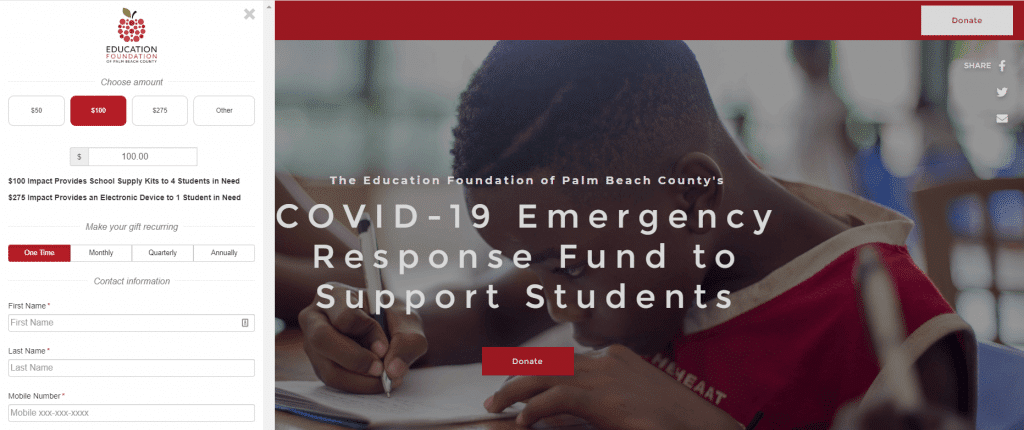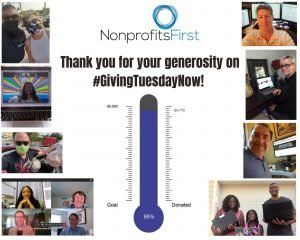“What if we offend people by asking for donations right now?”
“We have enough funding from our savings and/or grants to hold us over for awhile.”
“We have so much going on right now – how can we even find time to fundraise?”
“Our board thinks we shouldn’t be asking for donations right now…”
These are all direct quotes from actual conversations I’ve had with nonprofit friends and clients over the past few weeks. Make no mistake, current times are challenging. For many nonprofits, events that were expected to bring in fundraising dollars have been cancelled and internal processes have undergone drastic changes to adhere to social distancing guidelines – all while staff, volunteers, and clients are grappling with the difficulties of the “new normal”.
- Further your mission.
- Provide services to your clients.
- Communicate with your donors.

It is no secret that Achieve is a big fan of the Education Foundation of Palm Beach County*, not to mention the major impact they have on over 122,000 students right in our backyard.
- Multi-Channel Campaign: This campaign is featured on the Education Foundation website, has a unique landing page, is being promoted on various social media platforms, includes a text-to-give component, rallies community partners, and more! This is great because it opens up more opportunities for supporters to learn about the campaign (and understand why support is needed).
- Text-To-Give: In 2020 almost all of us have our smartphones easily within reach all day, every day. By offering a text-to-give option, tech savvy supporters have an even easier way to donate.
- Landing Page: For some fundraising efforts, driving supporters to a simple donation form isn’t going to cut it. By using a standalone landing page, the Education Foundation can provide information and updates for the campaign in one centralized place while leveraging a customized donation form with recommended giving tiers (see next bullet point).
- Giving Tiers: By attaching real world impact to recommended giving tiers, donors may be more inclined to give. In the case of Education Foundation’s campaign – their donation form defaults to the first recommended giving tier ($100 to provide school supply kits for 4 students in need), then jumps to the next recommended giving tier ($275 to provide an electronic device for 1 student in need), and also includes a $50 tier as well as an “other” custom amount tier.

What They Did It:
- Press Release: Nonprofits First set the stage for a great peer-to-peer campaign by sharing a press release across multiple social media platforms (and asking their board to share across their channels), emailing the press release article to supporters, and posting the release within each peer-to-peer Facebook fundraiser.
- 8 Facebook Fundraisers: Remember when I said two heads are better than one? While the bulk of funds raised from this campaign came from Facebook, it took 8 separate fundraisers to raise almost $3,500! By working together, Nonprofits First was able to maximize results.
- Email: Nonprofits First didn’t get hung up on only using Facebook fundraisers to garner donations. In fact, one fourth of all funds were raised through their web online donation form! It is important to make it easy for people to donate and in this instance some supporters preferred receiving an email and completing their donation on the Nonprofits First website.
- Said Thank You: One of my pet peeves as a fundraising professional and donor is when nonprofits forget to say thank you. That being said, the Nonprofits First team did an amazing job of saying thank you! I observed emails, Facebook posts, Facebook comments, Facebook messages, posts within each Facebook fundraiser, and more – all saying thank you to specific donors and/or thanking supporters as a whole.

What They Did:
- Collaboration: Instead of trying to create a new virtual event out of thin air, SMART Ride collaborated with the hysterical and well known drag queen Dixie Longate (she has performed over 1,000 shows in 5 countries). Dixie was kind enough to provide the entertainment and donate all Tupperware proceeds from the event to SMART Ride .
- Zoom: Some virtual events require expensive software or fancy apps attendees need to download. Alternatively, this event kept it simple with a Zoom call for up to 300 participants. I felt this worked great because most attendees already knew how to use Zoom, plus the chat feature allowed for socialization with other attendees.
As we all navigate this global pandemic together, when communicating with donors remember
- Talk about any challenges you or your clients are facing.
- Highlight your organizations “why”.
- Show impact (and/or impact that is needed).
- Share “wins” or testimonials.
- Modify messaging as needed.
- Test-and-learn new ideas.
- Say donations will go towards COVID-19 related efforts if they won’t.
- Act like everything is “back to normal”.
- Forget to say thank you.